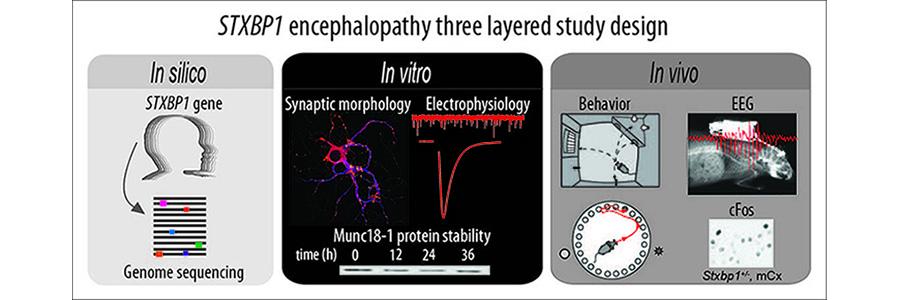
A team of FGA/CNCR researchers together with US/Swedish partners (SUN project) and VU spin-off Sylics characterize mechanisms underlying the seizures and cognitive deficits in STXBP1-encephalopathy and present several new animal models.

STXBP1-encephalopathy, also known as early infantile epileptic encephalopathy with burst-suppression (EIEE4) or Ohtahara syndrome, is one of the severest and earliest forms of developmental disorders and is characterized by epileptic seizures, infantile spasms, developmental delay and intellectual disability. The underlying disease mechanism is largely unknown and treatment options are very limited.
In 2008, Saitsu et al. first identified mutations in the STXBP1 gene in the patients suffering from early infantile epileptic encephalopathy (Saitsu et al., 2008). The study now published in the journal Brain, Jovana Kovačević (right) and colleagues investigated the underlying disease mechanisms and developed animal models using a multilevel approach with in silico, in vitro and in vivo studies. The authors conclude that protein instability, haploinsufficiency, and cortical hyperexcitability together explain STXBP1-encephalopathy.
In this new study, in silico analyses of publically available genomics data of hundreds of thousands of humans show that pathogenic mutations in STXBP1 gene are ultra-rare, probably due to extremely strong consequences of STXBP1 mutations for normal brain development and -function.
 The authors then tested an allelic series of STXBP1 mutations in cell culture system (in vitro) and found that all mutations lead to a decreased cellular level of the STXBP1 protein, implicating protein instability as the underlying factor to explain the disease. A previous study from the same lab has previously shown that lower protein levels cannot support normal synaptic transmission, at least not during intense neuronal activity. This situation is known as haploinsufficiency; normal expression of both copies of a gene is required for normal function. New analyses in neurons from STXBP1-encephalopathy patients will elucidate if protein instability is indeed an underlying cause in patients.
The authors then tested an allelic series of STXBP1 mutations in cell culture system (in vitro) and found that all mutations lead to a decreased cellular level of the STXBP1 protein, implicating protein instability as the underlying factor to explain the disease. A previous study from the same lab has previously shown that lower protein levels cannot support normal synaptic transmission, at least not during intense neuronal activity. This situation is known as haploinsufficiency; normal expression of both copies of a gene is required for normal function. New analyses in neurons from STXBP1-encephalopathy patients will elucidate if protein instability is indeed an underlying cause in patients.

Original Research: Open access article https://academic.oup.com/brain/article-lookup/doi/10.1093/brain/awy046
DOI: 10.1093/brain/awy046.